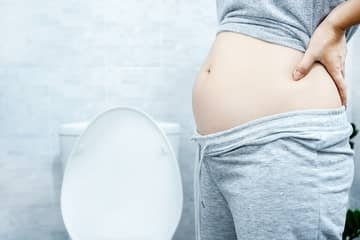
Kegel exercises in pregnancy for the pelvic floor. Exercises for pregnant + video
If you are planning a pregnancy or are already pregnant, the concept of Kegel exercises is guaranteed to enter your consciousness. It is well known that during pregnancy various hormonal and physiological changes take place in a woman's body, which a woman can feel as well as observe. The area of the small pelvis is loaded many times more during pregnancy. It is precisely the muscles of the pelvic floor that bear the increased load of the fetus, uterus, placenta or bladder. Strengthening the pelvic floor, which Kegel exercises also provide, brings many benefits. They help prevent incontinence, reduce the risk of a dropped pelvic floor - stronger pelvic floor muscles make childbirth easier, and even Kegel exercises have benefits in the sexual area as well. How to exercise pelvic floor muscles? What are the best pelvic floor exercises for women? Are these exercises suitable for pregnant women?
In the case of Kegel exercises, women don't have to have unrealistic ideas about a tough training session in the gym, during which they sweat liters of sweat. You can perform such an exercise from the comfort of your home, and all you need is a comfortable exercise mat. The principle of this exercise consists in strengthening the muscles of the pelvic floor - the area of the vagina, urethra, bladder or anus. The muscles of the pelvic floor represent a kind of support for the organs in the small pelvis. A weakened pelvic floor brings with it certain risks that can be eliminated by technically correct exercises. Strengthening the pelvic floor is suitable even before pregnancy, but Kegel exercises are intended for pregnant women and can also be practiced after childbirth. What are the benefits of Kegel exercises for women? How to practice Kegel exercises correctly?
What are Kegel exercises?
The tradition of Kegel exercises dates back to the 19th century, but to 1948, when the American gynecologist Arnold Kegel published ideas related to strengthening the pelvic floor in order to prevent stress- female incontinence and pelvic floor prolapse. Later it turned out that these exercises comprehensively benefit the overall health of the genital organs.
The goal is to strengthen the pelvic muscles, the activation of which improves their overall condition. Pelvic muscles provide direct support for organs located in the small pelvis (bladder, urethra, uterus, small intestine, large intestine, rectum). Good condition of the pelvic floor muscles is not only important for pregnant women, but also for women outside the pregnancy period (note, for example, for older women who have a higher risk of urinary incontinence). By applying these exercises to men, the benefits for the male sex were also confirmed.
What is it about? Strengthening exercises are based on proper breathing, contraction and release of specific pelvic muscles, thanks to which they become stronger and more flexible. Because the exercises actively involve the pelvic floor, the muscles in this area are much more resistant and can better withstand the excessive intra-abdominal pressure that arises when lifting heavy loads or during pregnancy due to the action of the fetus and the growing uterus.
Since the pelvic muscles are part of the center of the body (core), they also affect the condition of the spine. Kegel exercises are primarily associated with postpartum women, as they help regenerate the pelvic muscles as a result of weakening during childbirth. At the same time, they are suitable as prevention before or during pregnancy. In addition, Kegel exercises for the pelvic floor are also suitable for women in menopause, when the pelvic muscles become significantly weaker, and for women after a hysterectomy (note: removal of the uterus due to tumors or fibroids, excessive bleeding, changes in the uterine lining, etc.).

Strengthening of the male bottom - benefits
The benefits of Kegel exercises are relatively broad-spectrum, and their good condition is a great prevention against the emergence of several health problems after childbirth or in later life. Exercising the pelvic muscles during pregnancy provides, or it increases the support of the pelvic organs and effectively prevents the pelvic floor from sagging - it can even lead to the prolapse of the uterus or other pelvic organs. Especially after childbirth, this musculature can be weakened so much that it cannot hold the organs and they fall or fall towards the vagina. Alternatively, this problem may manifest itself with increasing age, as this muscle weakens due to natural stress.
Another benefit of strengthening the pelvic floor is that it is possible to significantly eliminate the occurrence of incontinence, i.e. the involuntary leakage of urine after childbirth or at a later age. Kegel exercises even represent one of the possible therapies in the event that incontinence even appears in a woman. During pregnancy, leakage of urine can occur precisely as a result of excessive abdominal pressure exerted on the pelvic muscles. Women often feel the urge to urinate or leak urine when they cough, sneeze or laugh. The risk of faecal incontinence (leakage of stool) and hemorrhoids is also reduced.
Kegel exercises help significantly reduce pain during childbirth, thanks to the fact that the active involvement of muscles increases their flexibility and resistance. They are also better for regeneration after tearing or incision of the perineum (episiotomy).
Strong pelvic floor muscles also help women in the area of intimacy, by ensuring increased excitement, which increases the chance for women to reach orgasm more easily. Exercises benefit the overall health of the genitals. Blood circulation in the vaginal area improves (note also in the rectal area) and the vaginal muscles are stronger. Experiencing sexual intercourse is thus painless and more intense. The pelvic muscles are part of the center of the body, strengthening them also improves the condition of the spine.
Kegel exercises are not a purely female affair. Strengthening the pelvic floor is also important for men. Engaging these muscles with appropriate exercises helps to improve blood circulation in the genital area. It also has a positive effect on the prostate. Last but not least, the conscious control of these muscles contributes to a better erection (for problems with erectile dysfunction) and by activating them at the right time, it is possible to delay ejaculation (problems with premature ejaculation).
Sagging pelvic floor - uterine drop
The descent of the uterus, which is called prolapse, means the condition when the uterus descends towards the vagina. The reason for this condition is that the muscles and ligaments of the pelvic floor are so weakened that the uterus and pelvic organs drop. The severity of prolapse can vary, and only a gynecologist can classify the condition through an examination. Most often, the uterus decreases after childbirth or with increasing age (genetic factors).
One of the possible methods of treatment is applying exercises to the pelvic floor. Another solution can be a vaginal pessary, which represents a kind of barrier against further descent of the uterus, and in a critical phase, surgical intervention is necessary. The descent of the uterus is manifested by a feeling of pressure in the small pelvis, discomfort, leakage of urine, lower back pain, increased frequency of inflammation, production of discharge or vaginal bleeding, and depending on the phase of the descent, sexual intercourse is also painful.

Condition of the pelvic floor muscles - test
Pregnant young women might believe that their pelvic floor is strong and flexible just because of their young age. However, this is no guarantee. Therefore, there are several ways to find out what condition a woman's pelvic muscles are in. If you do not have typical symptoms such as the urge to urinate, incontinence (one of the first symptoms) or a feeling of discomfort or pressure in the lower abdomen, you can try a simple trick. Go to the toilet for a small need. After you start urinating, try to consciously contract the muscles in the vaginal area, and you should be able to stop the flow of urine. If you succeed, your pelvic floor muscles are in good condition (note: this is only a pelvic muscle test, do not use intermittent urination as an exercise method). This is a relative term, because during pregnancy the pelvic area will face much stronger intra-abdominal pressure, therefore it is recommended to apply Kegel exercises during pregnancy as a form of prevention.
Kegel exercises for strength and endurance are another method of checking the condition of the pelvic muscles. In this case, you lie on your back on the exercise mat and bend your legs, which you put slightly apart. In the attached video in the paragraph below, you can see that the first exercise is about building the strength of the pelvic floor muscles by pulling them in and out. A woman performs regulated contractions at a low frequency. In the second exercise, the same exercise is performed, but in this case it is a measurement of a time interval of 10 seconds, during which the pelvic muscles must be contracted. In the third exercise, strength and endurance are combined with contraction activity with a higher frequency.
How to practice Kegel exercises?
When practicing Kegel exercises, it is extremely important that they are performed correctly. The advantage is that they are very undemanding, but due to their nature it is more difficult to show them. It often happens that women control only the superficial muscles of the vagina and anal sphincter during exercise. However, it is not only a mechanical movement of the muscles, breathing is important so that it is possible to work with the muscle tissue deeper in the pelvis. It is important to learn to feel the necessary muscles. When stopping urine, you should work exclusively with the muscles in the area of the vagina and its interior. You should not tighten your stomach, butt muscles or push your thighs together. When testing (e.g. intermittent urination) your muscles, aim to feel the area around the anus and vagina being pulled upwards towards the pelvis as the muscles contract
Furthermore, breathing is very important and must also be controlled during exercise. Never hold your breath while doing these exercises. Inhale must be directed to the abdomen, exhalation smoothly towards the pelvis - spine. Progress in training by increasing the load, start with one set, fewer repetitions and learn to control the necessary muscle group. The exercises are performed lying on the back.
Examples of simple exercises for the pelvic floor
- Exercise no. 1 – lie on your back, the entire horizontal axis of the body is in contact with the ground. Then bend your legs at the knees, put them slightly apart. Pull in the muscles of the anus and vagina with a breath, as if you were trying to stop urination. Stay like this for at least 10 seconds and then relax.
- Exercise no. 2 – get on all fours, with your knees and palms touching the ground. In the initial position, the back is straight. Then, make a cat's back, that is, you bend the spine towards the mountain together with an inhale, tighten the abdomen, glutes and vagina. Hold for at least 10 seconds. Relax and while exhaling, gradually straighten your spine and point your head towards the ceiling.
- Exercise no. 3 – lie on your back, the spine and buttocks are in contact with the ground. The legs are bent at the knees, pointing slightly apart and the feet touching the ground. Put your hands behind your head (like a sit-up) and slowly raise your shoulder blades and try to lift your butt off the mat with a smooth movement. On the way up, don't forget to inhale and draw in the pelvic floor. In the upper position, you contract the gluteal and pelvic muscles. Your torso and pelvis should be in one plane. The entire movement must be fluid and not dynamic. Stay in the upper position for 5 to 10 seconds.
How often to practice Kegel exercises?
As with any other exercise, it is necessary to form a habit. Regular exercise is key to effectively strengthening the pelvic floor. Start with simple strokes for a few seconds. Even several times a day. Schedule individual exercises into individual parts of the day. Gradually decide that you will exercise at this hour, at this place and at this time. Start slowly with one set of exercises. It is gradually recommended to exercise at least 3 times a day, while you should gradually manage 3 to 4 sets with the number of repetitions of 10 to 20. It is the regularity that is important in order to see the results. After about 10 weeks of exercise, the real results of the exercise are observable. For incontinence problems, the problem is usually eliminated with regular exercise within 6 months.
Kegel exercises in pregnancy - experience
Kegel exercises are well known to many pregnant and postpartum women. Several women in the discussions ask, above all, how to implement such exercises. In this regard, women most often turn to gynecologists, who will recommend special booklets with exercise manuals. Women also advise each other in discussions about how they performed individual Kegel exercises or pelvic floor exercises in general . Many women ask for advice even after giving birth because they have a problem with urine leakage. Some discussants state that they started strengthening the pelvic floor a month after giving birth. As for Kegel exercises, women use this exercise mainly during pregnancy, because it is an easy exercise that does not require specific positions for exercise.
The most frequent questions - FAQ
Are you interested in what Kegel exercises are ? Why are Kegel exercises a suitable physical activity during pregnancy? In our article, you will learn the most important things about this form of exercise. You will also find out why strengthening the pelvic floor is so important. Such exercise is even suitable as a prevention before pregnancy and it is also a suitable exercise after childbirth. Do you have experience with Kegel exercises? When did you start practicing them? We will be happy if you join the discussion and share your experiences with other readers. Do you have any advice and recommendations when applying individual exercises? In the discussion section you can add your comment and express your opinion.
Are Kegel exercises for the pelvic floor?
Why are the muscles of the pelvic floor weakened during pregnancy?
What does a prolapsed pelvic floor mean?
What are Mojžiš' exercises for the pelvic floor?
Pridať komentár






